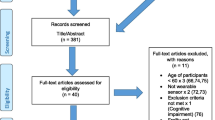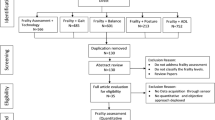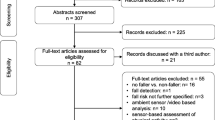Abstract
Background and objective
Sensor technology, in particular wearable inertial sensors, has the potential to help researchers objectively assess the functionality of older adults. The following review provides an overview about the possible use of sensor technology to detect and prevent pre-frailty and frailty.
Method
A systematic literature search in PubMed and the Cochrane Library was conducted. Articles were selected according to the following criteria: frail and/or pre-frail population, use of wearable and non-wearable sensor technology to measure or enhance human movements or activities of daily living and a focus on frailty assessment.
Results
A total of 28 publications were found. Sensor-derived parameters obtained during assessment of gait, functional performances and physical activity were reported to be relevant for screening and monitoring pre-frailty and frailty; however, current findings are limited to cross-sectional studies, which do not allow establishment of a causal relationship between motor performance, physical activity and specific frailty states. No study monitored specific activities of daily living.
Discussion
Outcome variables from technology-based assessment seem to provide valuable information for frailty assessment. Strenuous testing conditions as well as increased variability in gait, functional performance and physical activity may be useful in identifying frailty. Outcome variables derived from gait, motor assessment and physical activity must still be validated in large cohorts and under daily living conditions in order to develop robust screening tools for pre-frailty and frailty. Further research should focus on specific activities of daily living in pre-frail or frail older adults and technology-based approaches for intervention and prevention.
Zusammenfassung
Hintergrund und Zielsetzung
Sensortechnologie und speziell tragbare Inertialsensorik kann die Funktionalität älterer Menschen messen und bewerten. Im folgenden Review wird ein Überblick gegeben, inwieweit Sensortechnologie (Pre-)Frailty erkennen und der Prävention dienen kann.
Methoden
Eine systematische Literaturrecherche in PubMed und Cochrane Library wurde mit folgenden Einschlusskriterien durchgeführt: (pre-)fraile Studienpopulation, Einsatz tragbarer und/oder nicht tragbarer Sensortechnologie zum Messen oder Fördern von Bewegung und Aktivitäten des täglichen Lebens und Fokus auf Frailty-Assessment.
Ergebnisse
Insgesamt 28 Artikel wurden identifiziert. Sensorparameter für den Gang, das motorische Assessment und die körperliche Aktivität eignen sich zum Screening und Monitoring von (Pre-)Frailty. Kausalbeziehungen zwischen Sensorparametern und Frailty-Status können aufgrund mangelnder Längsschnittstudien jedoch bislang nicht abgeleitet werden. Ein sensorbasiertes Monitoring spezieller Aktivitäten des täglichen Lebens erfolgte nicht.
Diskussion
Technologiegestützte Assessmentparameter können wertvolle Informationen zum Frailty-Assessment beitragen. Sensorparameter von Gang, motorischem Assessment und körperlicher Aktivität sollten in großen Stichproben und unter Alltagsbedingungen validiert werden, um robuste Screening-Instrumente für (Pre-)Frailty zu entwickeln. Zukünftige Projekte sollten sich darüber hinaus auf spezifische sensorbasiert gemessene Aktivitäten des alltäglichen Lebens und technologie-gestützte Ansätze zur Prävention und Intervention bei (Pre-)Frailty fokussieren.

Similar content being viewed by others
References
Collard RM, Boter H, Schoevers RA, Oude Voshaar RC (2012) Prevalence of frailty in community-dwelling older persons: a systematic review. J Am Geriatr Soc 60:1487–1492. doi:10.1111/j.1532-5415.2012.04054.x
Dapp U, Minder CE, Anders J, Golgert S, von Renteln-Kruse W (2014) Long-term prediction of changes in health status, frailty, nursing care and mortality in community-dwelling senior citizens-results from the Longitudinal Urban Cohort Ageing Study (LUCAS). BMC Geriatr 14:141. doi:10.1186/1471-2318-14-141
Daintith J (2009) A dictionary of physics, 6th edn. Oxford University Press, Oxford
Morgenstern U, Kraft M (eds) (2014) Biomedizinische Technik – Faszination, Einführung, Überblick. De Gruyter, Berlin
Greene BR, Doheny EP, O’Halloran A, Anne Kenny R (2014) Frailty status can be accurately assessed using inertial sensors and the TUG test. Age Ageing 43:406–411. doi:10.1093/ageing/aft176
Schwenk M, Mohler J, Wendel C, D’Huyvetter K, Fain M, Taylor-Piliae R, Najafi B (2015) Wearable sensor-based in-home assessment of gait, balance, and physical activity for discrimination of frailty status: baseline results of the Arizona frailty cohort study. Gerontology 61:258–267. doi:10.1159/000369095
Theou O, Jakobi JM, Vandervoort AA, Jones GR (2012) A comparison of physical activity (PA) assessment tools across levels of frailty. Arch Gerontol Geriatr 54:e307–e314. doi:10.1016/j.archger.2011.12.005
Thiede R, Toosizadeh N, Mills JL, Zaky M, Mohler J, Najafi B (2016) Gait and balance assessments as early indicators of frailty in patients with known peripheral artery disease. Clin Biomech (Bristol, Avon) 32:1–7. doi:10.1016/j.clinbiomech.2015.12.002
Regterschot GRH, Zhang W, Baldus H, Stevens M, Zijlstra W (2016) Accuracy and concurrent validity of a sensor-based analysis of sit-to-stand movements in older adults. Gait Posture 45:198–203. doi:10.1016/j.gaitpost.2016.02.004
Alexander GL, Rantz M, Skubic M, Koopman RJ, Phillips LJ, Guevara RD, Miller SJ (2011) Evolution of an early illness warning system to monitor frail elders in independent living. J Healthc Eng 2:337–363
Ranasinghe DC, Shinmoto Torres RL, Hill K, Visvanathan R (2014) Low cost and batteryless sensor-enabled radio frequency identification tag based approaches to identify patient bed entry and exit posture transitions. Gait Posture 39:118–123. doi:10.1016/j.gaitpost.2013.06.009
Moher D, Liberati A, Tetzlaff J, Altman DG (2009) Preferred reporting items for systematic reviews and meta-analyses: the PRISMA statement. PLOS Med 6:e1000097. doi:10.1371/journal.pmed.1000097
Morley JE, Vellas B, van Kan GA, Anker SD, Bauer JM, Bernabei R et al (2013) Frailty consensus: a call to action. J Am Med Dir Assoc 14:392–397. doi:10.1016/j.jamda.2013.03.022
Cesari M, Prince M, Thiyagarajan JA, de Carvalho IA, Bernabei R, Chan P et al (2016) Frailty: an emerging public health priority. J Am Med Dir Assoc 17:188–192. doi:10.1016/j.jamda.2015.12.016
Morley JE (2014) Frailty screening comes of age. J Nutr Health Aging 18:453–454. doi:10.1007/s12603-014-0457-9
Rockwood K, Theou O, Walston J (2015) Operationalizing frailty using the frailty phenotype and deficit accumulation approaches. Interdiscip Top Gerontol Geriatr 41:66–73. doi:10.1159/000381164
Bandeen-Roche K, Seplaki CL, Huang J, Buta B, Kalyani RR, Varadhan R et al (2015) Frailty in older adults: a nationally representative profile in the united states. J Gerontol A Biol Sci Med Sci 70:1427–1434. doi:10.1093/gerona/glv133
Fabbri E, Zoli M, Gonzalez-Freire M, Salive ME, Studenski SA, Ferrucci Aging Multimorbidity L (2015) New tasks, priorities, and frontiers for integrated gerontological and clinical research. J Am Med Dir Assoc 16:640–647. doi:10.1016/j.jamda.2015.03.013
Buta BJ, Walston JD, Godino JG, Park M, Kalyani RR, Xue Q‑L et al (2016) Frailty assessment instruments: systematic characterization of the uses and contexts of highly-cited instruments. Ageing Res Rev 26:53–61. doi:10.1016/j.arr.2015.12.003
Drey M, Pfeifer K, Sieber CC, Bauer JM (2011) The Fried frailty criteria as inclusion criteria for a randomized controlled trial: personal experience and literature review. Gerontology 57:11–18. doi:10.1159/000313433
Fried LP, Tangen CM, Walston J, Newman AB, Hirsch C, Gottdiener J et al (2001) Frailty in older adults: evidence for a phenotype. J Gerontol A Biol Sci Med Sci 56:M146–M156
Kim M‑J, Yabushita N, Kim M‑K, Nemoto M, Seino S, Tanaka K (2010) Mobility performance tests for discriminating high risk of frailty in community-dwelling older women. Arch Gerontol Geriatr 51:192–198. doi:10.1016/j.archger.2009.10.007
Schwenk M, Howe C, Saleh A, Mohler J, Grewal G, Armstrong D, Najafi B (2014) Frailty and technology: a systematic review of gait analysis in those with frailty. Gerontology 60:79–89. doi:10.1159/000354211
Najafi B, Helbostad JL, Moe-Nilssen R, Zijlstra W, Aminian K (2009) Does walking strategy in older people change as a function of walking distance? Gait Posture 29:261–266. doi:10.1016/j.gaitpost.2008.09.002
Mohler MJ, Fain MJ, Wertheimer AM, Najafi B, Nikolich-Zugich J (2014) The Frailty syndrome: clinical measurements and basic underpinnings in humans and animals. Exp Gerontol 54:6–13. doi:10.1016/j.exger.2014.01.024
Martinez-Ramirez A, Martinikorena I, Gomez M, Lecumberri P, Millor N, Rodriguez-Manas L et al (2015) Frailty assessment based on trunk kinematic parameters during walking. J Neuroeng Rehabil 12:48. doi:10.1186/s12984-015-0040-6
Mohler MJ, Wendel CS, Taylor-Piliae RE, Toosizadeh N, Najafi B (2016) Motor performance and physical activity as predictors of prospective falls in community-dwelling older adults by frailty level: application of wearable technology. Gerontology. doi:10.1159/000445889
Moe-Nilssen R, Helbostad JL (2005) Interstride trunk acceleration variability but not step width variability can differentiate between fit and frail older adults. Gait Posture 21:164–170. doi:10.1016/j.gaitpost.2004.01.013
Gillain S, Petermans J (2013) Contribution of new techniques to study the gait in old populations. Ann Phys Rehabil Med 56:384–395. doi:10.1016/j.rehab.2013.05.002
Clegg A, Young J, Iliffe S, Rikkert MO, Rockwood K (2013) Frailty in elderly people. Lancet 381:752–762. doi:10.1016/S0140-6736(12)62167-9
Galan-Mercant A, Cuesta-Vargas AI (2014) Differences in trunk accelerometry between frail and non-frail elderly persons in functional tasks. BMC Res Notes 7:100. doi:10.1186/1756-0500-7-100
Millor N, Lecumberri P, Gomez M, Martinez-Ramirez A, Izquierdo M (2014) Kinematic parameters to evaluate functional performance of sit-to-stand and stand-to-sit transitions using motion sensor devices: a systematic review. IEEE Trans Neural Syst Rehabil Eng 22:926–936. doi:10.1109/TNSRE.2014.2331895
Ganea R, Paraschiv-Ionescu A, Bula C, Rochat S, Aminian K (2011) Multi-parametric evaluation of sit-to-stand and stand-to-sit transitions in elderly people. Med Eng Phys 33:1086–1093. doi:10.1016/j.medengphy.2011.04.015
Galan-Mercant A, Cuesta-Vargas AI (2013) Differences in trunk accelerometry between frail and nonfrail elderly persons in sit-to-stand and stand-to-sit transitions based on a mobile inertial sensor. JMIR Mhealth Uhealth 1:e21. doi:10.2196/mhealth.2710
Millor N, Lecumberri P, Gomez M, Martinez-Ramirez A, Izquierdo M (2013) An evaluation of the 30-s chair stand test in older adults: frailty detection based on kinematic parameters from a single inertial unit. J Neuroeng Rehabil 10:86. doi:10.1186/1743-0003-10-86
Ganea R, Paraschiv-lonescu A, Aminian K (2012) Detection and classification of postural transitions in real-world conditions. IEEE Trans Neural Syst Rehabil Eng 20:688–696. doi:10.1109/TNSRE.2012.2202691
Greene BR, Doheny EP, Kenny RA, Caulfield B (2014) Classification of frailty and falls history using a combination of sensor-based mobility assessments. Physiol Meas 35:2053–2066. doi:10.1088/0967-3334/35/10/2053
Martinez-Ramirez A, Lecumberri P, Gomez M, Rodriguez-Manas L, Garcia FJ, Izquierdo M (2011) Frailty assessment based on wavelet analysis during quiet standing balance test. J Biomech 44:2213–2220. doi:10.1016/j.jbiomech.2011.06.007
Galan-Mercant A, Cuesta-Vargas AI (2014) Mobile Romberg test assessment (mRomberg). BMC Res Notes 7:640. doi:10.1186/1756-0500-7-640
Chen S, Honda T, Chen T, Narazaki K, Haeuchi Y, Supartini A, Kumagai S (2015) Screening for frailty phenotype with objectively-measured physical activity in a west Japanese suburban community: evidence from the Sasaguri Genkimon Study. BMC Geriatr 15:36. doi:10.1186/s12877-015-0037-9
Peters LL, Boter H, Buskens E, Slaets JPJ (2012) Measurement properties of the Groningen Frailty Indicator in home-dwelling and institutionalized elderly people. J Am Med Dir Assoc 13:546–551. doi:10.1016/j.jamda.2012.04.007
Song J, Lindquist LA, Chang RW, Semanik PA, Ehrlich-Jones LS, Lee J et al (2015) Sedentary behavior as a risk factor for physical frailty independent of moderate activity: results from the osteoarthritis initiative. Am J Public Health 105:1439–1445. doi:10.2105/AJPH.2014.302540
Soaz C, Diepold K (2015) Step detection and parameterization for diagnosis and monitoring of functional decline using a single waist-worn accelerometer. IEEE Trans Biomed Eng. doi:10.1109/TBME.2015.2480296
Troiano RP, Berrigan D, Dodd KW, Masse LC, Tilert T, McDowell M (2008) Physical activity in the United States measured by accelerometer. Med Sci Sports Exerc 40:181–188. doi:10.1249/mss.0b013e31815a51b3
McCullagh R, Brady NM, Dillon C, Horgan NF, Timmons S (2015) A review of the accuracy and utility of motion sensors to measure physical activity of frail older hospitalised patients. J Aging Phys Act. doi:10.1123/japa.2014-0190
Hollewand AM, Spijkerman AG, Bilo HJ, Kleefstra N, Kamsma Y, van Hateren KJ (2016) Validity of an accelerometer-based activity monitor system for measuring physical activity in frail elderly. J Aging Phys Act. doi:10.1123/japa.2014-0290
Chang Y‑C, Lin C‑C, Lin P‑H, Chen C‑C, Lee R‑G, Huang J‑S, Tsai T‑H (2013) eFurniture for home-based frailty detection using artificial neural networks and wireless sensors. Med Eng Phys 35:263–268. doi:10.1016/j.medengphy.2011.09.010
Fontecha J, Hervas R, Bravo J, Navarro FJ (2013) A mobile and ubiquitous approach for supporting frailty assessment in elderly people. J Med Internet Res 15:e197. doi:10.2196/jmir.2529
Hewson DJ, Jaber R, Chkeir A, Hammoud A, Gupta D, Bassement J et al (2013) Development of a monitoring system for physical frailty in independent elderly. Conf Proc IEEE Eng Med Biol Soc 2013:6215–6218. doi:10.1109/EMBC.2013.6610973
de Folter J, Gokalp H, Fursse J, Sharma U, Clarke M (2014) Designing effective visualizations of habits data to aid clinical decision making. BMC Med Inform Decis Mak 14:102. doi:10.1186/s12911-014-0102-x
Rockwood K, Andrew M, Mitnitski A (2007) A comparison of two approaches to measuring frailty in elderly people. J Gerontol Ser A Biol Sci Med Sci 62(7):738–743
Mitnitski AB, Mogilner AJ, Rockwood K (2001) Accumulation of deficits as a proxy measure of aging. The Sci World J 1:323–336. doi:10.1100/tsw.2001.58
Espinoza S, Fried L (2007) Risk factors for frailty in the older adult. Clin Geriatr 15(6):37–44
Rolfson DB, Majumdar SR, Tsuyuki RT, Tahir A, Rockwood K (2006) Validity and reliability of the Edmonton Frail Scale. Age Ageing 35(5):526–529. doi:10.1093/ageing/afl041
Weiss A, Herman T, Plotnik M, Brozgol M, Giladi N, Hausdorff JM (2011) An instrumented timed up and go: the added value of an accelerometer for identifying fall risk in idiopathic fallers. Physiol Meas 32:2003–2018. doi:10.1088/0967-3334/32/12/009
Regterschot GRH, Zhang W, Baldus H, Stevens M, Zijlstra W (2015) Sensor-based monitoring of sit-to-stand performance is indicative of objective and self-reported aspects of functional status in older adults. Gait Posture 41:935–940. doi:10.1016/j.gaitpost.2015.03.350
Marschollek M, Goevercin M, Wolf KH, Song B, Gietzelt M, Haux R, Steinhagen-Thiessen E (2008) A performance comparison of accelerometry-based step detection algorithms on a large, non-laboratory sample of healthy and mobility-impaired persons. Conf Proc IEEE Eng Med Biol Soc 2008:1319–1322. doi:10.1109/IEMBS.2008.4649407
Lindemann U, Zijlstra W, Aminian K, Chastin SFM, de Bruin ED, Helbostad JL, Bussmann JBJ (2013) Recommendations for standardizing validation procedures assessing physical activity of older persons by monitoring body postures and movements. Sensors (Basel) 14:1267–1277. doi:10.3390/s140101267
Coley B, Najafi B, Paraschiv-Ionescu A, Aminian K (2005) Stair climbing detection during daily physical activity using a miniature gyroscope. Gait Posture 22:287–294. doi:10.1016/j.gaitpost.2004.08.008
Geraedts HAE, Zijlstra W, van Keeken HG, Zhang W, Stevens M (2015) Validation and user evaluation of a sensor-based method for detecting mobility-related activities in older adults. PLOS ONE 10:e0137668. doi:10.1371/journal.pone.0137668
Ranasinghe DC, Shinmoto Torres RL, Sample AP, Smith JR, Hill K, Visvanathan R (2012) Towards falls prevention: a wearable wireless and battery-less sensing and automatic identification tag for real time monitoring of human movements. Conf Proc IEEE Eng Med Biol Soc 2012:6402–6405. doi:10.1109/EMBC.2012.6347459
Huisingh-Scheetz MJ, Kocherginsky M, Magett E, Rush P, Dale W, Waite L (2016) Relating wrist accelerometry measures to disability in older adults. Arch Gerontol Geriatr 62:68–74. doi:10.1016/j.archger.2015.09.004
Robben SMB, Pol MC, Buurman BM, Krose BJA (2016) Expert knowledge for modeling functional health from sensor data. Methods Inf Med. doi:10.3414/ME15-01-0072
Acknowledgements
We would like to thank Sandra Hellmers, Sebastian Fudickar and Thomas Gerhardy for the help with the literature search terms and the literature search.
Author information
Authors and Affiliations
Corresponding author
Ethics declarations
Conflict of interest
L. Dasenbrock, A. Heinks, M. Schwenk and J.M. Bauer state that they have no competing interests.
This article does not contain any studies with human participants or animals performed by any of the authors.
Rights and permissions
About this article
Cite this article
Dasenbrock, L., Heinks, A., Schwenk, M. et al. Technology-based measurements for screening, monitoring and preventing frailty. Z Gerontol Geriat 49, 581–595 (2016). https://doi.org/10.1007/s00391-016-1129-7
Received:
Revised:
Accepted:
Published:
Issue Date:
DOI: https://doi.org/10.1007/s00391-016-1129-7




